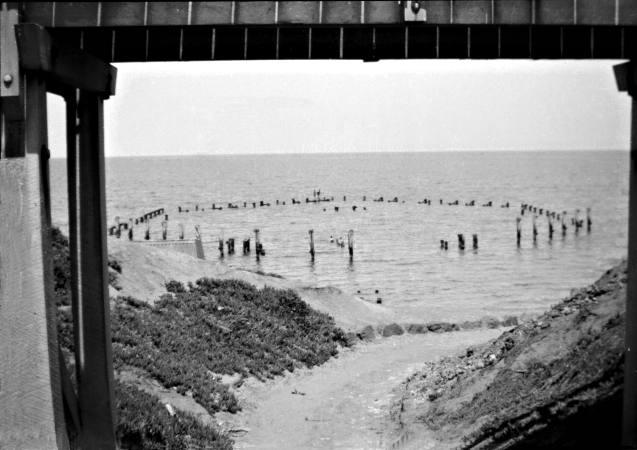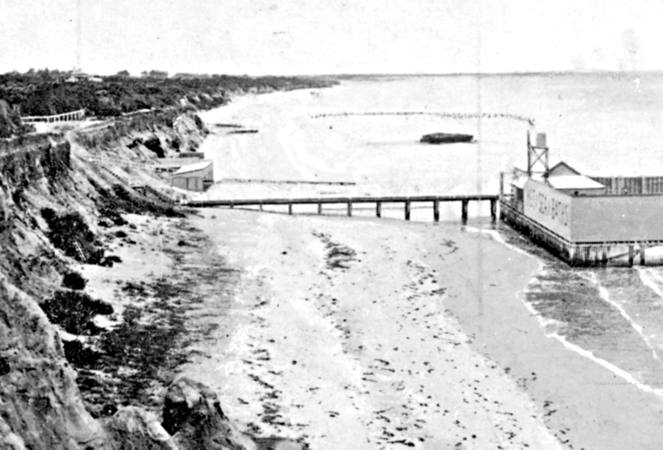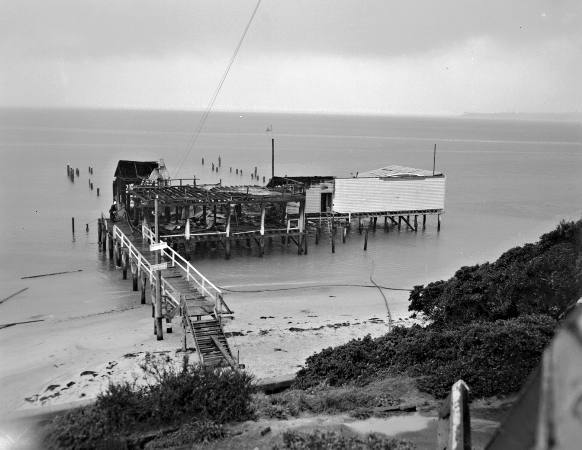Mentone Baths
As part of its strategy to attract buyers for its new fashionable subdivision, named Mentone, the National Land Company built public baths within walking distance of the town. They were constructed at the end of what is now called Warrigal Road in 1884 but only a short time later in December 1885 the company approached the Shire Council indicating their wish to sell the property. Although originally costing £1040 to construct the facility, the company was prepared to accept £350 for its sale. [1] The reasons why the company was prepared to accept such a poor return on their original investment are unknown but may have included relief from of the ongoing cost of maintenance, recognition that sparse population of the district would not generate a high income flow in the immediate future, and the sale would free up some of its invested capital while at the same time retaining a facility that attracted ongoing land sales.
It appears that the Council did not immediately seize the opportunity to purchase the community asset, but a little more than twelve months after the offer was made took over responsibility and management of the facility. Council minutes indicate that £1 was paid “as consideration for the Mentone Baths” a much-discounted price to that originally proposed. [2] The motion to purchase the baths as moved in council by Crs Sparks and Bent also made provision for tenders to be called to carry out needed repairs.
A few years later a correspondent to the Mentone and Moorabbin Chronicle [3] noted that the dressing rooms at the baths were in first class order but was concerned about the surrounding fence. With high tide, he pointed out, the fence could be hardly seen except for one or two stakes, and this he believed was hardly satisfactory for the protection of bathers from attacking sharks which abounded in great numbers in the waters off Mentone.

Old Baths with piles left standing 1928. Photographer Paul Lemmon, Courtesy Sheila Johnston.
Five months later a site was being selected for the erection of new baths at Mentone. Strongly supported by the local Board of Works in their efforts to promote their town, the new baths were seen as a way of attracting some of the tens of thousands of individuals who during the summer season frequented Brighton Beach and might be encouraged to journey a little further south to enjoy the natural beauty of the Mentone beach. The place chosen for the new facility was where the water was about five feet at low tide and about five chains from the ‘old’ baths. The expected cost was about £800. Included in the overall plan was the renovation of the old baths for the exclusive use of the ladies and young children, for at that time mixed bathing was considered inappropriate. [4]
There had been an incident at the old baths, where both men and women used them at different times, when some men in their eagerness to get to the water intruded before some ladies had vacated the premises whilst the ‘ladies flag’ was still flying. At that time a white flag indicated the facility was available to lady bathers while a red flag warned the gentler sex that it was the men’s turn. ‘Decency’ warned the management of the baths that should women be subjected to the indignity experienced by his wife and a lady friend, and decorum ignored, then patronage will be lost. [5] Writing in support of Decency’s letter, Resident suggested that lease should be cancelled if such boorish and inexcusable behaviour occurred again. [6]
Resident’s comment drew responses from several people including the lessee of the baths. Mr Webster acknowledged that the incident occurred but explained there had been a misunderstanding by his assistant who thought all the ladies had departed. He expressed his regrets to ‘Decency’ but thought Resident’s comments did not call for a reply. Indeed, he believed that Resident was in fact a person anxious to supplant him as lessee of the baths. [7] ‘A Bather’ wrote that Resident’s comments were harsh and extreme, and believed a private apology was all that was necessary. However, he suggested that to prevent a similar occurrence in the future a bell should be rung twenty minutes before closing time so that the ladies might have time to dress without trespassing on the gentlemen’s time. [8]
The proposal that the ‘old’ baths be repaired and made the exclusive domain of the women and children, while the new baths be available only to males, did not receive universal approval. At the time Council was calling of tenders for the construction of the new baths, the Council engineer saw repairing the old baths at an estimated cost of £180 as ‘useless expenditure’. [9] This attitude stirred ninety ladies to sign a petition to Council asking that the ‘old’ baths be maintained for their use but A Lady Bather objected seeing the cost involved as ‘superfluous expenditure.’ “Will husbands and fathers permit their masculine supremacy to snatch from their wives and children the luxurious boon that they enjoy themselves?” she wrote. “No doubt it is done unthinkingly and under the impression that special favor is bestowed on the ladies and children in giving them a bath exclusively to themselves without analysing or considering what they have to ensure in trudging nearly half a mile under a tropical sun for their morning sea bath” She went on to praise the Council for “getting constructed one the of the finest baths in the Southern Hemisphere,” but pleaded “let them not cause a vexation shadow to cloud their splendid achievement, by a misconception of lending themselves to the committal of so stupendous a blunder as to expend a large sum on getting the old baths repaired for the exclusive use of children and ladies when ladies do not want them and will not patronise them.” [10]
Despite the views of ‘A Lady Bather’, the Shire engineer, and possibly some other members of the community, the old baths were maintained for a few years. Indeed, early in 1892 the daily newspapers reported in a sensational fashion the capture of a shark there. The manager of the baths, Mr Logan, reported that one shark caught measured 3 feet six inches in length, a long way from the claimed six feet, while a second intruder escaped. Both were described as ‘gummies’, a common species in the bay that had no teeth and was perfectly harmless. Mrs McKeikan who was in about two feet of water with her two children when the fish were first seen and was able to lift her children from the water onto the safety of a platform before walking out herself. Later one of the so-called ‘monstrous sharks’ was on view in the vestibule of the Mentone Hotel. [11]
The council abandoned the old baths, probably because of excessive maintenance costs but also because a large section of the community believed women too should have access to the new facility a little further along the beach towards Mentone’s centre. In time the waves and other elements wreaked havoc on the old structure but many piles were still in place in the 1940s.

Mentone Baths 1907. Courtesy Ida Reynolds.
The new baths that were welcomed and praised by residents of the district were soon subjected to criticism. Mermaid, in 1899, pointed out that if one wanted a hot sea bath you had to go to Mordialloc as the heater at Mentone needed repair, and holes in the protecting fence were often left for some time before they were repaired providing the opportunity for sharks to intrude. She also claimed that it was scandalous that management allowed fathers and grandfathers to walk amongst young boys, all quite nude, disregarding the rewards of modesty. Mermaid wanted management to insist that men wear proper bathing costumes as was done by the ladies and so prevent “the gross outrage on decency.” [12]
When Mordialloc, Mentone, Parkdale and parts of Beaumaris seceded from the Shire of Moorabbin in 1920 three baths became the responsibility of the new Council. Mordialloc was given a valuation of £1000, Mentone £850 and Beaumaris £500. Each of these baths was described, in a 1926 publication promoting the new City, as having a splendid swimming area with ample dressing accommodation. Hot sea baths were available at both Mentone and Mordialloc. Flood lighting was also available at both these locations providing for night bathing. The Mentone Baths, in addition, had an open-air café and a fine dancing floor where locals and visitors could entertain themselves. [13]
By 1935 the Mordialloc Council engineer reported the baths needed an expenditure of £500 to restore them to an appropriate standard. (There had been a tremendous storm in December 1934 which wrecked many beach structures including the Mordialloc and Mentone baths.) This sum was calculated on the understanding that material from the Mordialloc Baths, at that time in the process of being dismantled, could be used. The Foreshore Committee in supporting the case for the expenditure pointed out that as the baths were the only ones left in the municipality their value would be materially increased and there would be an increased patronage from local schools and schools in the municipality of Chelsea. [14] Nevertheless, a move by the Council to spend £1000 on repairing the baths was strongly opposed by Cr Benwell who reminded his colleagues that since 1924 £2340 had been spent on the baths incurring an interest bill of £1051 against the raised bank loan. For him the whole structure was bad. There was not one sheet of iron or length of spouting that was not penetrated by rust, he claimed. Putting money into repairs was throwing money away. Flooring in the men’s dressing shed was in a state of decay and the lavatory at the end of the corridor was objectionable. Cr Benwell proposed instead that new baths would be constructed, “ones that would stand for all time.”
Although Benwell’s argument was supported by two colleagues the majority of councillors dismissed it. Cr Blanche was not afraid of spending the proposed £1000 as the Council had spent thousands of pounds on the foreshore without looking for a return. The mayor, Cr Dolamore, saw the issue as not whether they had new baths or old baths but rather whether they had old baths or none at all. He appreciated the need to improve the beach but he did not see it happening for ten or fifteen years. Cr Herbert pointed out that the council could not find the money to construct urgently needed roads let alone build elaborate beach structures. [15]
At a specially called meeting of the Foreshore Committee in October 1938 the City Engineer described the very poor condition of the baths and pointed out that the conditions were too severe for timber or iron. Any future buildings erected on the beach he advised should be constructed of masonry.. He noted eleven piles needed replacing, the whole of the roofing and spouting needed restoration, and the men’s conveniences and sun bathing floor now visible from the cliff top needed attention. Windows and door frames were rotting and all exposed walls needed a coat of paint. Careful costing had not been done due to lack of time but £1000 was a rough estimate of costs associated with repairing the existing structure. [16]
The question of restoring or rebuilding the baths lay relatively dormant for almost fourteen years. At the beginning of 1953 councillors once again became concerned about the derelict building, one of Melbourne’s greatest bayside eyesores, on the Mentone beach. Tenders were called for demolition.
The city engineer, Mr Galt, who had indicated his support for demolition pointed out the baths were not in a condition to be leased. If they were leased, he suggested, the lessee would have to guarantee they would be restored to a reasonable standard. This, a Mentone professional fisherman was prepared to do.
Mr C Farrow of Plummer Road, Mentone, owner of the Mentone Beach Store opposite the baths, believed he could make the derelict facility a paying proposition with the establishment of a good kiosk and perhaps hot sea baths. There was also an opportunity to provide a safe anchorage for professional fishermen. As a carrot to the Council to accept his offer, he indicated his willingness to have a fully equipped rescue boat available at all times at the baths for those who got into difficulty on the bay. [17] Farrow warned the Council that the baths were being increasingly subjected to vandalism and if this continued they would soon be beyond the stage of restoration. A decision on action was urgent, Farrow claimed. Despite this urgency Council was still attempting to reach a resolution eight months later. [18]
During this period, the Parkdale Yacht Club revealed its interest in taking over the baths as a club house and believed they had the support of the councillors for its proposal. The club undertook in their planning to repair the baths and provide dressing facilities for the public but when attending a Council meeting discovered the baths had been declared unsafe, unfit for human habitation and without electrical power. That information, Graham Walker, the commodore of the club said, finished our application. It was just a fortnight later that the club discovered that the baths had been leased as a kiosk to Mr Farrow. [19]
Some years after the initial attempt by the Parkdale Yacht Club to gain a lease of the baths building the club tried again by writing to the Minister of Lands indicating their wish to lease the buildings to stow yachts and equipment. The Minister replied that the current tenant had purchased the baths from the Council and they should approach the Council with their request. This they did only to meet with further frustration.
The town clerk, Mr J Grut, pointed out that the baths site was originally held under an annual licence from the Department of Crown Lands and Survey, but the Council had sold the structure and relinquished the licence to occupy the site to Mr Farrow. He referred the club back to the department of Crown Lands and Survey resulting in the club running around in circles. [20]

Mentone Baths from the cliff top, 1962. Courtesy Leader Collection.
By 1962 the Council had made contact with several government departments in an effort to have the baths demolished but without success. Mr Farrow was disappointed about their actions for although the baths were in a dilapidated state, during the summer months approximately 1,500 children swam there. This he claimed was because he provided clean dressing sheds, showers and toilets without charge. Physical eduction teachers from the Education Department were grateful that the baths existed.
Later that year the matter was finally resolved, when ironically, during a very heavy downpour of rain, the baths were destroyed by fire. Although the fire brigade was quickly called the firemen standing in waist deep water and directing the hoses at the seat of the fire were unable to control the blaze. Mr Farrow who lived at the baths was away at the time of the fire but his kelpie dog perished. [21] The remains of the baths were removed and Mr Farrow moved to Queensland. No effort was made by Council to replace the destroyed structure to attract visitors or provide local residents with sea baths that many had enjoyed in earlier years.

Mentone Baths after the fire, 1962. Courtesy Leader Collection.
Footnotes
- Shire of Moorabbin, Minute Book 5, December 21, 1885.
- Shire of Moorabbin, Minute Book 5, February 14, 1887.
- Mentone and Mordialloc Chronicle, April 5, 1890.
- Brighton Southern Cross, September 27, 1890.
- Mentone and Moorabbin Chronicle, January 10, 1891.
- Mentone and Moorabbin Chronicle, January 17, 1891.
- Mentone and Moorabbin Chronicle, January 24, 1891.
- Mentone and Moorabbin Chronicle, January 24, 1891.
- Brighton Southern Cross, October 11, 1890.
- Mentone and Moorabbin Chronicle, April 4, 1891.
- Mentone and Moorabbin Chronicle, February 4, 1892.
- Brighton Southern Cross, May 13, 1899.
- The History of Mordialloc, 1926.
- Mordialloc News, June 29, 1935.
- Mordialloc News, September 16, 1938.
- Mordialloc News, October 14, 1938.
- Mordialloc City News, April 16, 1953.
- Mordialloc City News, December 3, 1953.
- Mordialloc City News, October 8, 1959.
- Mordialloc City News, January 29, 1959.
- Mordialloc City News, August 9, 1962.
